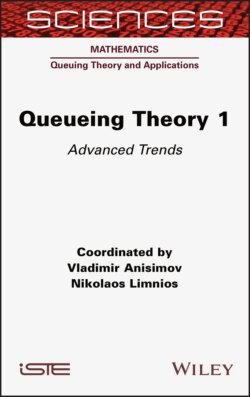Читать книгу Queueing Theory 1 - Nikolaos Limnios - Страница 12
1.1. Introduction
ОглавлениеMost of the queueing models in the literature usually assume that the interarrival times and service times are independent of each other. While this may be true in some instances, it was pointed out by Cidon et al. (1993) that there are instances where there are dependencies between the two distributions. They mentioned that in communication systems where finite speed of communications links constrain the amount of data that can be received, one finds the interarrival times and service times to be correlated. They studied communication systems in which the interarrival time between nth and st customer depends naturally on the service time Bn of the customer. In a subsequent paper, Cidon et al. (1996) studied queues with interarrival times proportional to service times. Earlier, Fendick et al. (1989) did demonstrate that the dependence between successive service times and interarrival times for data packets can be important. Also in another earlier paper, John (1963) considered the case where the service time depends on the interarrival times and gave examples of applications. Benes (1957, 1960) was the first not to assume that interarrival times and service times are both independent of each other. It is, however, surprising that there has been limited amount of work following up on that.
Chao (1965) captured the interdependence between interarrival times and service times by using a bivariate exponential distribution to capture the two processes. By defining the correlation between the interarrival and service times as ρ, Chao (1965) pointed out that a customer’s waiting time is monotonically decreasing in ρ in increasing convex ordering sense. While this seems common sense, it was the first confirmation based on rigorous analysis. Later, Muller (2000) studied the waiting times when there is dependency between amount of work (service time) brought by a customer and the subsequent interarrival times. He showed that the stronger the dependency is between interarrival times and service times, the more the waiting time decreases in increasing convex ordering sense (similar to Chao 1995). Hadidi (1981a, 1981b) used bivariate exponential distribution for the joint interarrival and services times to capture the dependency, and carried out simulation and numerical studies to understand the effects of the correlation coefficient on waiting times.
One of the most recent works on this subject is by Iyer and Manjunanth (2006) who also studied the interarrival and service times of queue by using mixtures of bivariates. Panda et al. (2017), in a work similar to the one by Iyer and Manunanth (2006), studied queues in which batch interarrival and service times are correlated by representing them with a bivariate mixture of rational (R) distributions.
Generally, most of the reported works focus on proportional relationships between interarrival times and service times. This is quite limiting. In this chapter, this aspect is relaxed, and the interdependence between the interarrival times and services is captured in a one-way dependence of interarrival time on service time and later in a two-way dependence. However, that dependence is allowed to be general. In the one-way case, we start by considering the Geo/Geo/1 system in which the arrival probability depends on service completion probability. Specifically in the general one-way case, we assume that there is a set of several, but finite, number of interarrival times. At the end of a service completion, the next interarrival time of a user is selected based on the service time. Even though the distributions of the interarrival times and service times will be general, we will be using the discrete phase type distribution to represent them based on the fact any discrete general distributions, with finite support, can be represented by a Markov chain (Alfa 2004).
